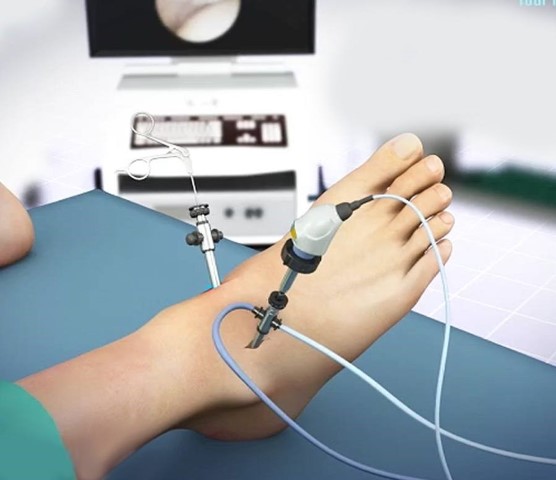Ankle keyhole surgery or arthroscopy is the process of inserting a small telescope and instruments through keyhole incisions in the ankle joint
If you are suffering from ankle arthritis, osteochondral lesions or require ankle fusion surgery on an ankle fracture or ankle sprain/ ankle instability or the surgeon needs to examine and repair tendons and ligaments, then you may need to have this minimally invasive procedure. Images of the inside of the joint are displayed on a monitor in the operating theatre.
Quicker healing with reduced risk of infection
Better results for many procedures, including ankle fusion surgery
INDICATION of ANKLE ARTHROSCOPY
Ankle Arthritis :
Ankle arthroscopy offers a minimally invasive way to perform ankle fusion.
Ankle Fracture :
This can help to ensure normal alignment of bone and cartilage. It also may be used during ankle fracture repair to look for cartilage injuries inside the ankle.
Ankle Instability :
Ligaments of the ankle can become stretched out, which can lead to a feeling that the ankle “gives out.”. Arthroscopic techniques may be an option for treating instability.
Anterior ankle impingement :
Ankle impingement occurs when bone or soft tissue at the front of the ankle joint becomes inflamed. Arthroscopy can be used to shave away inflamed tissues and bone spurs.
Arthrofibrosis :
Scar tissue can form within the ankle. This can lead to a painful and stiff joint, known as arthrofibrosis. Ankle arthroscopy can be used to identify the scar tissue and remove it.
Loose bodies :
Cartilage, bone, and scar tissue can become free floating in the joint and form what is referred to as loose bodies. Loose bodies can be painful and can cause problems such as clicking and catching. Locking of the ankle joint may occur. Ankle arthroscopy can be used to find and remove the loose bodies.
Osteochondral Defect :
These are areas of damaged cartilage and bone in the ankle joint.
Posterior ankle impingement :
This occurs when the soft tissue at the back of the ankle becomes inflamed. Pointing the foot down can be painful. The problem tissue can be removed with arthroscopy. Synovitis: The soft tissue lining of the ankle joint (synovial tissue) can become inflamed. Ankle arthroscopy can be used to surgically remove inflamed tissue that does not respond to nonsurgical treatment.
At least two small incisions are made in the front and/or back of the ankle. These portals become the entry sites into the ankle for the arthroscopic camera and instruments. Sterile fluid flows into the joint to expand it and allow for better visualization. The camera and instruments can be exchanged between portals to perform the surgery. Both motorized shavers and hand operated instruments are used. After the surgery is complete, sutures are placed to close the portals. A sterile dressing is placed over the sutures. A splint or boot is often used.



